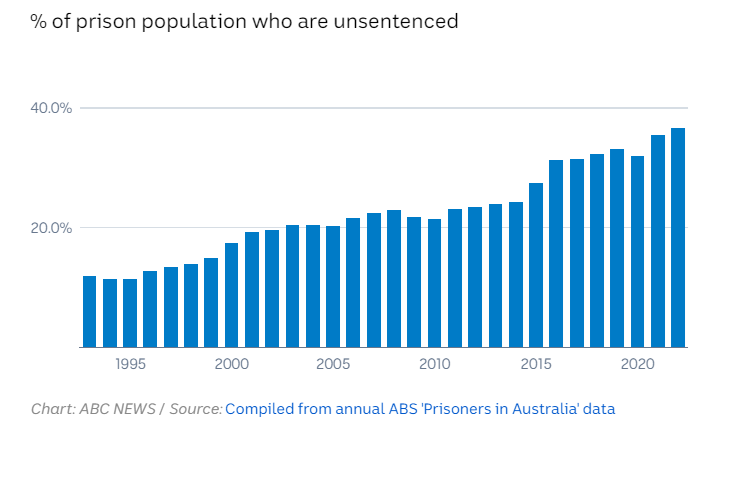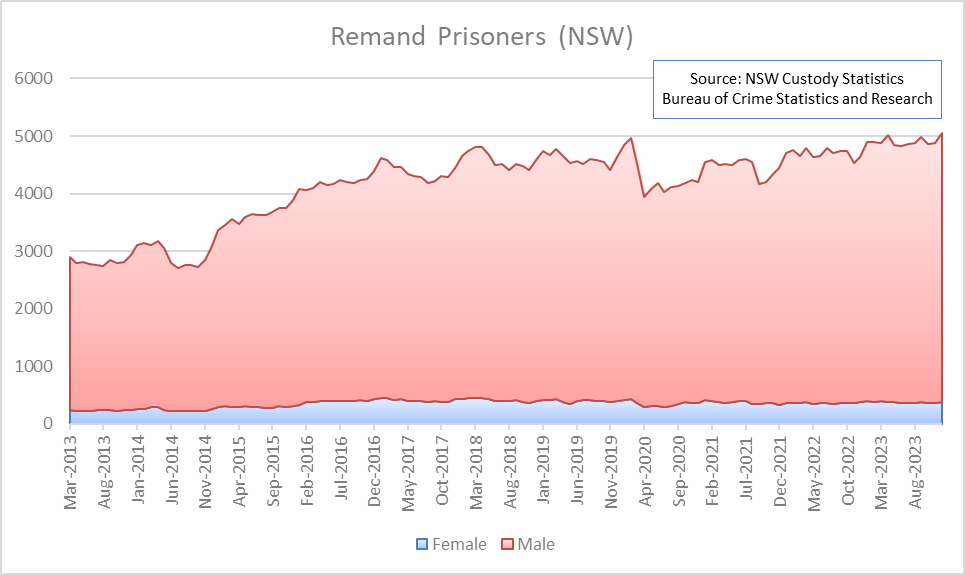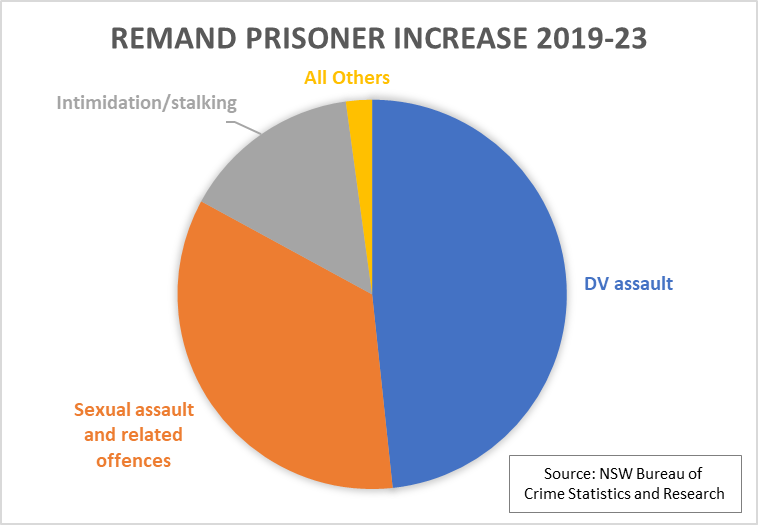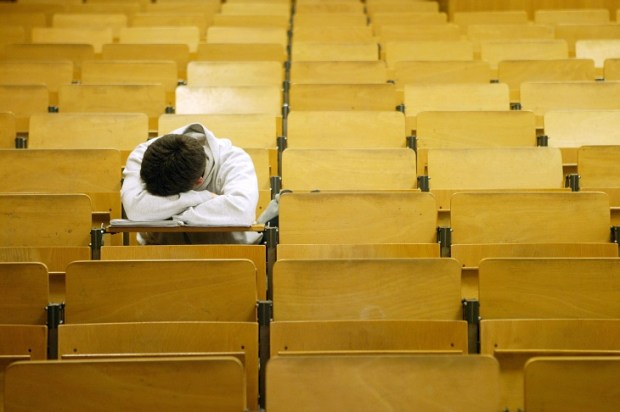This is an experienced criminal lawyer talking about the men, the increasing proportion of our prison population, who find themselves imprisoned without a trial. They are on remand and locked up in vile conditions with violent, dangerous people. They are being locked up because of changes to our bail legislation which are resulting in more and more men being refused bail – shut away for months, sometimes even years before their cases are determined.
Yet as I write this our media is inflamed, demanding fewer men should be let out on bail.
Every time a crime is committed by someone on bail, we see similar demands for tightening of the laws to ensure that everyone accused of any serious crime, particularly domestic violence, is safely locked away – even before there is any attempt to examine the evidence supporting the accusation at trial.
It’s easy to see why public sentiment is behind the demand to do more to protect vulnerable women in these circumstances. But the price we pay for knee-jerk responses to a very complex issue is that thousands of both legally and factually innocent men are locked up in jails across the country.
It is very easy to argue that there will never be an offence committed by a person on bail if nobody is ever granted bail. But the true cost of such a position needs to be understood.
Sure, we can reduce the risk of offending by removing bail as an option. And we can increase the likelihood of convictions by implementing a reverse onus in what we perceive to be ‘problem’ areas of crime. In fact, we can absolutely ensure that all persons suspected of committing a crime are summarily convicted, just by removing the right to a trial. But do we want to live in such a place?
Right now, across this country more than a third of men in Australian prisons haven’t had their case determined by a court. In national trends, the number of unsentenced people in custody almost doubled, reaching 16,000 in the past decade. The proportion continues to go up – with a 15.5 per cent increase in the last five years.

In NSW, 42 per cent of prisoners are now on remand – which means that they are legally innocent. Yet they are behind bars.

‘They are presumed to be innocent and a lot of these offences are not offences where, if they were convicted, they would necessarily go to jail,’ comments Lorana Bartels, a professor of criminology at ANU.
There has been a recent (and astonishing) increase in presumed innocent people being locked up is due to what we might call ‘feminist offences’ – offences allegedly committed mainly by males which the women’s lobby has worked hard to ensure are punished severely. That means, ideally, putting the alleged perpetrator behind bars.
This feminist campaign has been a great success with a record number of prisoners on remand. In NSW, the overall remand prisoner population has increased by 74 per cent in the last 10 years and is now 92 per cent male.
Naturally, our biased media plays down the fact that mainly men are being impacted. Some publications claim, falsely, in my view, that the recent changes that resulted in this increase ‘disproportionately affect Indigenous Australians, the homeless and women’.
Yet the crimes the feminists have targeted – sexual assault, domestic violence, intimidation/stalking and the like – make up 98 per cent of the increase in remand prisoners in the last 4 years, according to data provided to us by BOSCAR. Domestic violence and sexual assault account for 83 per cent of the increase.

Of course, there are shocking cases of women on remand, but these cases are rare compared to the huge number of men finding themselves in this situation. For instance, we never hear about the men now routinely imprisoned without a trial after accusations of domestic violence. For every two men in prison who have been convicted of domestic violence, there are three who have been charged but not tried.
As we know, no actual evidence is required to make a domestic violence accusation and have a man charged. A mere allegation by an angry ex-spouse is often sufficient to have her partner given an apprehended violence order and then, by setting up a few breaches of that order, put into jail.
The same applies to sexual assault, as we have seen from five judges’ comments in NSW which led to the audit of current rape cases.
Another lawyer explains how the humiliations for these men pile up: ‘For low-level offences, the police should issue notices to attend court but instead they are arresting men wherever they can find them, i.e. at home or at work. Handcuffing them and transporting them to police stations where they can then be questioned for many hours before charging them. This is all done in the traumatic cell environment where they will be ultimately searched and fingerprinted and formally charged.’
‘Depending on the time of the day they will then be sent to a remand facility. These facilities are horrendous, with full strip searches, three men to large concrete cells, free-standing toilets in full view, 24-hour lights on, thinnest mattresses on concrete slabs, atrocious food and no entertainment of any sort.’
The cells were like ‘hosed-out dog kennels’, an ex-remand prisoner told me, describing the damp, freezing cells.
Imprisoned men simply disappear into the system, and it can be a mighty task even for their lawyers to find out where they are.
And they are certainly not safe. ‘People in jail live in the midst of violence. People are arbitrarily attacked and often severely injured,’ the criminal lawyer explained.
Another topic to consider is that of stalking – 57 per cent of those imprisoned for intimidation or stalking are merely accused, not convicted. Think about that – most people jailed for stalking are there solely based only on an accusation. They haven’t even received a trial.
Our state governments had better start building more prisons fast given the expected tsunami of men likely to be charged with the new criminal offence of coercive control, due in the next year or so. That one is a dead certainty for denial of bail, given how hard the feminists have worked to claim coercive control is linked to domestic homicide – no matter how strong the evidence showing that is not the case – see here.
So, what was it that triggered this big shift towards locking people up without a trial? Following demands from the media similar to those occurring today, bail laws were reformed in 2013 and 2021 so that the presumption of bail was revoked for some offences, requiring that courts assess bail risk and a ‘show cause’ test that puts the onus on people charged with the most serious offences to justify why they should be given bail.
Only sexual offences involving minors are on the current list but the default position is already refusal of bail for most sexual assault offences. Now the push is now on for all sexual assault offences to be included in the ‘show cause’ list, including allegations involving lack of consent. Can you imagine the consequences if all young men being accused of such crimes were immediately locked up without a trial?
When it comes to domestic violence, the reality is that in the current culture most magistrates will err on the side of caution – ‘in case something happens’. They will rarely give bail if they perceive that there is any risk of violence. Even with less serious offences involving domestic violence breaches, risk-averse magistrates are (understandably) readily convinced to take the easy way out.
The consequence of these changes to bail laws is that the rate of bail refusals has increased by 47.3 per cent over last 9 years according to BOCSAR. This means more and more remand prisoners even though crime rates have been on a dramatic decline.
NSW Greens MLC David Shoebridge commented that this change ‘undermines the presumption of innocence for every citizen in NSW, and is an attack on this fundamental principle in our criminal justice system.’
The writing is on the wall, and it is very, very scary.

























